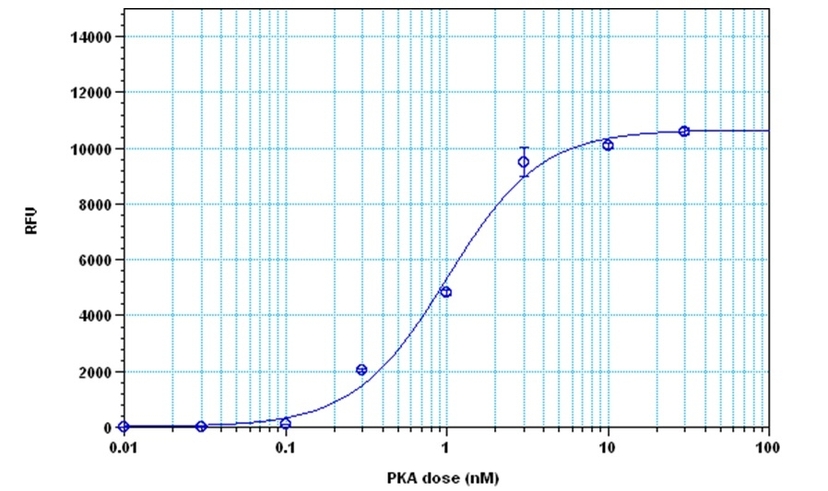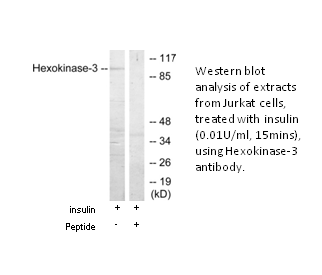Overview of Common Kinases
by Becky Graves

Kinase enzymes, responsible for the phosphorylation of biomolecules, are critical components in molecular activity and their ability to bind to other molecules. Kinase enzymes largely impact and regulate important physiological processes such as cell division and development, protein synthesis and regulation, metabolism, immunity, and signal transmission. There are three main kinds of kinases - protein, lipid, and carbohydrate - each dependent on the substrate that it attaches to. In addition, there are several kinase enzymes that act upon nucleotides. Kinase enzymes are present in the living cells of everything from microorganisms to plants and animals. In total, over 530 kinase enzymes have been identified in humans with most of them classed as protein kinases (PTKs).
Depending on the amino acid residue that is phosphorylated, protein kinases are comprised of five key groups - serine/threonine kinases (ST-PKs), tyrosine kinases (TKs), aspartic acid/glutamic acid-specific kinases, dual-specificity kinases, and histidine-specific kinases. As their name indicates, a phosphate group is transferred to the hydroxyl group of the corresponding target of a particular protein. The largest families of protein kinases are ST-PKs and TKs.
Lipid kinases, which total approximately twenty, phosphorylate lipids in the cell plasma membranes and the membranes of organelles, increasing the rate of reactions and transmission signaling. Chiefly consisting of Diacylglycerol kinases (DGK or DAGK), phosphatidylinositol 3-kinases (Pl3Ks) or sphingosine kinases (SphK), lipid kinases have become a focused component in the designing of drugs, namely for cancers and in various therapies.
Carbohydrate kinases' main function is to activate monosaccharides by adding a phosphate group, generally from ATP to an available sugar hydroxyl. The five most common carbohydrate kinase classes are:
The most known carbohydrate kinases are the HKs, consisting of hexokinases and glucokinases (GKs), which act at influential regulation points to facilitate biochemical pathways by phosphorylating sugars at the hydroxyl group. RKs are prevalent in anabolic reactions with high specificity toward their substrate. ROKs are kinase enzymes largely found in bacteria and are structurally similar to HKs. The superfamily GHMPKs are ATP-dependent enzymes that take part in carbohydrate metabolism, and the biosynthesis of isoprene and amino acids. Finally, the Pl-Ks are divided further into groups - PI3Ks, PI4Ks, and PIP5Ks - based on the subcellular localizations and functions, all of which are critical factors in specific metabolic pathways.
There are kinases within this large enzyme family that range in prominence and attention as a research target, even outside of these three main classes. For example, kinases that phosphorylate nucleosides, nucleoside-diphosphate kinases (NDPKs), are vital for the production of nucleoside triphosphates (NTPs). NTPs are major components of cellular metabolism (notably the citric acid cycle) and multiple other areas of cellular activity, including in nucleic acid synthesis, G protein-coupled receptor function, and more.
Kinase
Regulation and Function of Protein Kinase
Protein Kinases Overview: Definition, Types, Function, Activation Mechanism, etc.
Diacylglycerol Kinases: Relationship to Other Lipid kinases
GHMP kinase, C-terminal domain superfamily
Original created on February 13, 2024, last updated on February 13, 2024
Tagged under: enzymes, kinases

The detection of protein kinase A with the Amplite® Fluorimetric Kinase Assay Kit. The kinase was incubated in the presence of ATP and peptide substrate for 30 minutes, and ADP generation was detected using the kit.
Depending on the amino acid residue that is phosphorylated, protein kinases are comprised of five key groups - serine/threonine kinases (ST-PKs), tyrosine kinases (TKs), aspartic acid/glutamic acid-specific kinases, dual-specificity kinases, and histidine-specific kinases. As their name indicates, a phosphate group is transferred to the hydroxyl group of the corresponding target of a particular protein. The largest families of protein kinases are ST-PKs and TKs.
- Common ST-PKs include Cyclin-dependent kinases (CDKs), which are critical in cell regulation and operation, mitogen-activated kinases (MAPKs) that directly control such processes as cell differentiation, proliferation, and embryogenesis, and Protein-Kinase D (PKD), responsible for transport across membranes, cell growth, and migration, which are activated by Protein-Kinase C (PKC).
- Tyrosine Kinases are generally grouped into a few different classes, each responsible for mediation between cells and signaling transduction. Non-receptor tyrosine protein kinases (NRTKs), receptor-tyrosine kinases (RTKs) and nuclear tyrosine protein kinases are the three primary classifications.
| Basis Of Differentiation | GPCRs | RTK |
| Definition | Is a type of cell surface receptor that has seven transmembrane domains | Is a type of enzyme-linked cell surface receptor that has 2 monomers and consists of a single transmembrane domain |
| Energy molecule | Uses GTP as its energy source | Uses ATP as its energy source |
| Linked enzymes | None | Enzyme kinases |
| Single ligand binding | Ligand binding induces only one cell response | Ligand binding induces multiple cell responses |
| Cell signaling pathways | The cytosine residues get methylated | The lysine residues get acetylated |
| Chemical modification | GPCRs typically activate intracellular signaling pathways via G proteins and second messengers | RTKS normally activate intracellular signaling pathways via phosphorylation (when adaptor proteins or protein kinases attach to phospho tyrosines on the RTK molecule) |
| FAQs: |
Lipid kinases, which total approximately twenty, phosphorylate lipids in the cell plasma membranes and the membranes of organelles, increasing the rate of reactions and transmission signaling. Chiefly consisting of Diacylglycerol kinases (DGK or DAGK), phosphatidylinositol 3-kinases (Pl3Ks) or sphingosine kinases (SphK), lipid kinases have become a focused component in the designing of drugs, namely for cancers and in various therapies.
| Datasets: | |
Carbohydrate kinases' main function is to activate monosaccharides by adding a phosphate group, generally from ATP to an available sugar hydroxyl. The five most common carbohydrate kinase classes are:
- Hexokinase (HK)
- Ribokinase (RK)
- Repressor, open-reading frame kinases (ROK)
- Galactokinase, homoserine, mevalonate, and phosphomevalonate kinase, (GHMPKs)
- Phosphatidylinositol phosphate kinases (Pl-Ks)
The most known carbohydrate kinases are the HKs, consisting of hexokinases and glucokinases (GKs), which act at influential regulation points to facilitate biochemical pathways by phosphorylating sugars at the hydroxyl group. RKs are prevalent in anabolic reactions with high specificity toward their substrate. ROKs are kinase enzymes largely found in bacteria and are structurally similar to HKs. The superfamily GHMPKs are ATP-dependent enzymes that take part in carbohydrate metabolism, and the biosynthesis of isoprene and amino acids. Finally, the Pl-Ks are divided further into groups - PI3Ks, PI4Ks, and PIP5Ks - based on the subcellular localizations and functions, all of which are critical factors in specific metabolic pathways.
There are kinases within this large enzyme family that range in prominence and attention as a research target, even outside of these three main classes. For example, kinases that phosphorylate nucleosides, nucleoside-diphosphate kinases (NDPKs), are vital for the production of nucleoside triphosphates (NTPs). NTPs are major components of cellular metabolism (notably the citric acid cycle) and multiple other areas of cellular activity, including in nucleic acid synthesis, G protein-coupled receptor function, and more.
| Datasets: | |
Products
Table 1. Related Kinase Products for Protein Kinase Activity
| Cat# ▲ ▼ | Product Name ▲ ▼ | Unit Size ▲ ▼ |
| 11410 | Amplite® Colorimetric Enterokinase Activity Assay Kit | 200 Tests |
| 31001 | Amplite® Universal Fluorimetric Kinase Assay Kit *Red Fluorescence* | 250 Tests |
| 31005 | ReadiUse™ Universal Kinase Reaction Stopping Buffer | 100 mL |
| 8A0459 | Aurora Kinase (Phospho-Thr288) Antibody | - |
| 8A0531 | p70 S6 Kinase (Phospho-Thr229) Antibody | - |
| 8A0532 | p70 S6 Kinase (Phospho-Ser371) Antibody | - |
| 8A0533 | p70 S6 Kinase (Phospho-Thr389) Antibody | - |
| 8A0534 | p70 S6 Kinase (Phospho-Ser418) Antibody | - |
| 8A0761 | Fructose 6 Phosphate Kinase (Phospho-Ser483) Antibody | - |
| 8A0783 | Breast Tumor Kinase (Phospho-Tyr447) Antibody | - |
References
Kinase
Regulation and Function of Protein Kinase
Protein Kinases Overview: Definition, Types, Function, Activation Mechanism, etc.
Diacylglycerol Kinases: Relationship to Other Lipid kinases
GHMP kinase, C-terminal domain superfamily
Original created on February 13, 2024, last updated on February 13, 2024
Tagged under: enzymes, kinases
